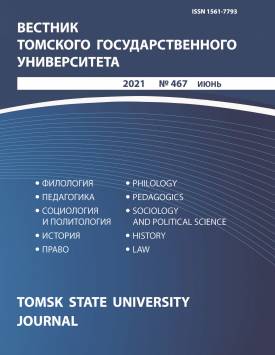The Evolution of the Literary Embodiment of One Plot: “The Alley of Forgotten Faces” and Time and Place by Yuri Trifonov
The article analyzes the plot Yuri Trifonov twice repeated in his creative practice: the story “The Alley of Forgotten Faces” (1970) and the chapter “The Lane Behind the Belorussky Station” from the novel Time and Place (1980). The aim of the work is to identify transformation points in the ways of transmitting a single story related to the memory of the time when the characters worked at an aircraft factory during the war. The factory, being a “place of memory” (P. Nora), provokes two types of recollection: a collision with the lane in the story becomes an incentive for the hero’s accidentally recall, while the novel reveals the main character’s conscious memory attitude as a reflexive strategy. Different attitudes dictate two ways of representing a single plot, expressed at different levels of text poetics. Thus, the image of the main character of the story is based on the opposition I-then/I-now, where I-then disappears from memory “forever”. This changes fundamentally in the novel: Trifonov, renouncing the opposition, introduces two narrators, whose constant change creates a polyphonic three-dimensional image that refutes the idea of the totality of disappearance. These attitudes are reflected in the reconstruction of the temporal context: if the character of the story focuses on then-perception, passing the memory about people and events through the prism of the “present” by detecting the value dominant of individual time, which is closed in time, the chapter of the novel focuses on the representation of historical time. The phrase “we made radiators for airplanes” repeated many times in the chapter becomes a marker of historical time, revealing its ontological nature, its “equalizing” and unifying function in relation to individual life manifestations. Depiction of the central episodes of both texts are subordinated to the attitudes of random and conscious recollection. When placed in the context of the final novel, events in the story, depicted through variations of extinction (the motif of the disappearance of illusions, the motif of premonition of disappearance), discover the expansion of artistic potential: two narrative voices break down the total space of the novel into the reality of a certain moment of life and the reality of a general context of Time and Place, which allows the characters to see different situations both in the moment of direct residence, and from a distance (the position of “tense being-out” according to Bakhtin). This contributes to adding the level of “doubled” reflection implicitly expressed by the hero himself and explicitly formulated by the second narrator to the event-factual level; the former level indicates the author’s worldview that fundamentally changed over the decade, which was expressed through the changed poetics of his later texts.
Keywords
Yuri Trifonov, plot, evolution of literary world, poetics of literary text, mechanisms of meaning generationAuthors
| Name | Organization | |
| Novosyolova Ekaterina A. | Ural Federal University | novosyolova_e@mail.ru |
References

The Evolution of the Literary Embodiment of One Plot: “The Alley of Forgotten Faces” and Time and Place by Yuri Trifonov | Vestnik Tomskogo gosudarstvennogo universiteta – Tomsk State University Journal. 2021. № 467. DOI: 10.17223/15617793/467/5
